#way out west 1937
Photo
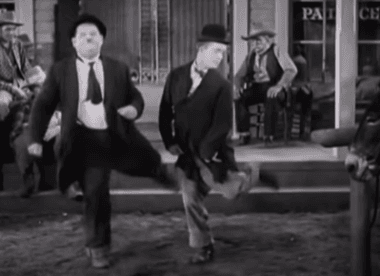
TGIF
#laurel and hardy gif#tgif gif#way out west#stan laurel#oliver hardy#30s movies#30s comedy#dance number#friday#1930s#1937#gif#chronoscaph gif
266 notes
·
View notes
Photo
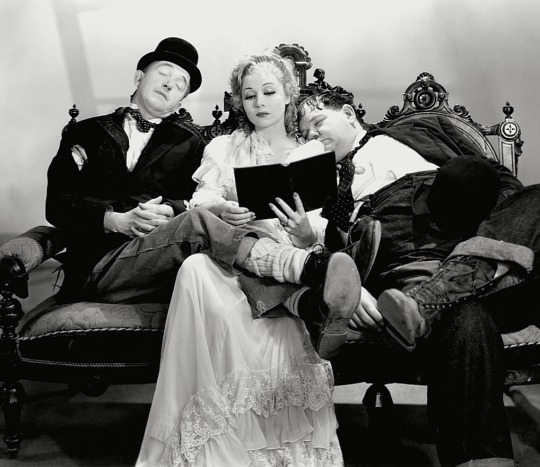
Stan Laurel, Sharon Lynne and Oliver Hardy
31 notes
·
View notes
Text
My father was a talker and a storyteller. Because of this, there was no time when we, his children, did not know we were Palestinian. The stories I remember about his boyhood in the 1930s and early 1940s were nostalgic, both comic and bitter. But there were more political stories that began to teach us what it had meant to be Palestinian under the British Mandate. According to my father, people were barely aware they were on the eve of disastrous events that would make them refugees. They did not realize that the Zionists, not the British, were their real adversaries.
Yet, while I was growing up, I don’t recall hearing his stories of 1948, the last months before the fall of his hometown, Jaffa. Were we too young to be told? Did it not mean anything to children who had never seen Jaffa? What happened when my father returned to Palestine was that his memories now became the guide to a living history and a real place. And he told the stories to me and to anyone who would listen.
Jaffa was the heart of my father’s Palestine. On the wall of his apartment in Ramallah when I came to stay in 2001 was a large sepia poster: a historic photograph of an Arab man staring wistfully out to sea with a large town in the background. At the top, in Arabic, it said, “Jaffa 1937.” On my first visit to Palestine to see him in 1993, I sensed the thrill he felt at having mastered the new situation. The good part was embracing and being embraced by the community he had found, whether in the West Bank or in various other parts of pre-1948 Palestine. The anxiety of being there was betrayed by his dry mouth and the beads of sweat on his forehead as he drove us around, approaching Israeli military checkpoints or getting lost because he couldn’t read Hebrew. For me, the landscape was familiar from Lebanon and Jordan, which I had known well growing up. The barren highways and the cities branded by Hebrew sounds and sights were menacing, though, especially when combined with the heavy presence of Israeli soldiers, reservists, and guns.
He was eager to show me and my small family the whole of Palestine, from Jerusalem to Bethlehem, Nablus to Nazareth, Jericho to ‘Akka. His tour of Jaffa, the same one, I was a little hurt to discover later, he gave to many others, was about claiming and reclaiming the city in which he had been born, the sea in which he had swum as a boy, and the home he had been forced to flee in 1948. On his own first visit in 1991, he’d asked friends to take him there. Initially he was disoriented. Most of the landmarks weren’t there. The neighborhood by the sea where he’d grown up had been razed by then, though twenty years earlier his brother had done what so many Palestinians have done and described: knocked on the door to find out which Jews—Russian, Moroccan, Yemeni, Polish—were now living in their old family homes. Suddenly, my father said he had spotted the Hasan Bek mosque where he had made the call to prayer as a boy. Bit by bit, circling more widely around the mosque, he began to find his way.
It was a former student of his who had made him rethink his refusal to go back. She often traveled to Israel and the Occupied Territories. He recalled that she had told him once, “Ibrahim, Palestine is still there.” He was happy, he said, to find this true. There is an image in one of Doris Lessing’s African Stories (1981) that has never left me. A young girl, a white settler living in southern Africa, looks out over the savanna and acacia trees and sees the large gnarled oak trees of her English fairytales. My father did the opposite. Where I, who never knew anything else, could see only the deep gouges in green hillsides made for Israeli settlements with garish red tile roofs, or miles and miles of highways criss-crossing the rocky landscape and claiming it with modern green signs in Hebrew and English, or non-native evergreen forests to hide razed villages, my father saw beyond, between and behind them to the familiar landscapes of his youth.
– Return to Half-Ruins: Father's and Daughters Memory and History in Palestine by Leila Abu-Lughod.
#newpad.txt#Palestine#I read this for a class and felt Abu-Lughods work is like... something folks need to read
1K notes
·
View notes
Text
Flamebird Analysis: The odd treatment of Bette Kane and her history/experience


Batwoman (2011-2016) #1
Okay so first of all, Kate; rude much?
Second of all... was Flamebird's costume really that impractical? Especaially when compared to Kate's costume.
While admittedly Flamebird's original costume was not exactly the height of practicality...
(Although she still seemed quite capable of holding her own in it)

Beast Boy (2000) #2
However she later does in fact get a more practical outfit which she also kickass ass in.

Beast Boy (2000) #4
And we do know that its Flamebird's second (more practical-looking costume) which Kate burns, as Bette ends up suiting up in her aforementioned spare after Kate fires her...
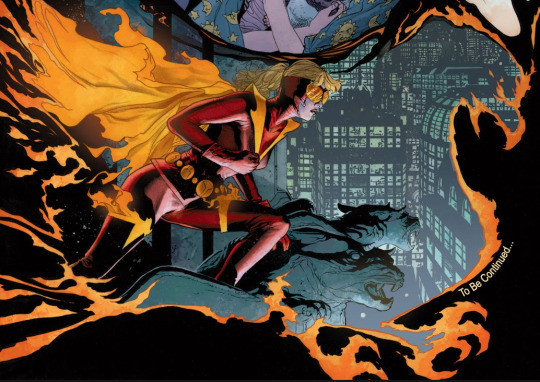
Batwoman (2011-2016) #3
While I am admittedly not an expert on combat outfits; Flamebird's second costume to me seems like it walks a good line between aesthetic and practicality. It has plenty of flair and style to it, but also appears quite flexible and overall not really too drastically different from Kate's Batwoman costume in this regard (rather hypocritical of Kate to say "you need a uniform" while she wears a long wig for no apparent reason apart from style).
If anything...
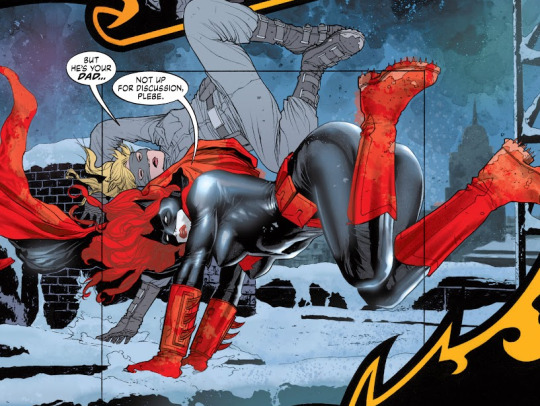
The "uniform" which Kate gives Bette kinda strikes me as being less practical for the situation compared to the Flamebird costume which she burned. Like Bette's mask seems to be just a piece of fabric tied around her face, which certainly feels like it should be looser and not be as sleek and flexible as the Flamebird costume.
Building off this, from what I've seen and looked over so far, the treatment of Bette kinda feels like it has a weird... juxtaposition at times between what's getting told and what's being shown, I guess.
Like on one hand...

It's shown by both Bette's comments here and the existence of her old Flamebird costumes that she has been experience vigilante for sometime. Longer than Kate I think, if I'm understanding the timeline all correctly.
There seems to be this odd case of both having Kate and the narrative treat Bette as an inexperienced rookie... while also having Bette and the narrative establish Bette as having been a Teen Titan, who has fought Deathstroke and presumably has years of experience.
Even Kate's codename for Bette indicates a rookie status...

However despite the references to Bette's past career and capabilities, and Bette's protests of being more capable than Kate gives her credit for, and Kate also immediately feeling quite shitty at how harsh she was when firing Bette...
The narrative still, from what I understand, kinda vindicates Kate entirely by having Bette get brutalised to the point of falling into a coma immediately after she defies Kate by heading out as Flamebird after getting fired... so I guess Kate was right? I don't know.
Like I said, I just find all of this quite of a weird portrayal. I've been curious about Bette lately on account of her being the original Batgirl (or rather, Bat-Girl), which is a very iconic mantle to the general "Bat-Mythos" even if Bette herself is far less remembered.
I guess one thing I find especially strange is how this is from the first issues of Batwoman 2011... meaning that this was right at the start of the whole New 52 Reboot stuff and so they could've presumably just retconned Bette's experience to make her an actual rookie sidekick instead of this weird half-measure where they both establish her past experience as canon while also otherwise ignoring it.
There's other stuff which I could go over; such as Bette's coma, her stint as Hawkfire, her enrolling in West Point... all of which probably has room for more detailed specific analysis by someone more familiar with both Bette and also the Batwoman comics (I've only fairly recently started looking into this stuff out of curiosity as I work my way through learning more comic history).
So I'll skip to a more recent appearance by Bette in 2017...
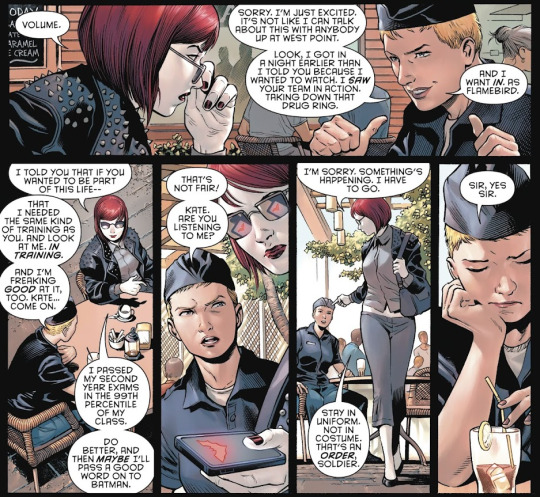
Detective Comics (1937—Present) #967
This whole exchange feels once again like Kate ignoring Bette's history, experience and capabilities. Especially the whole "pass second year in the top 99th percentile of your class and maybe I'll put in a good word with you to Batman" thing. No one else needed be top of their class at West Point, or attend West Point at all, to be a superhero. And it just seems strange to have Bette getting forced down that specific road.

Like; going by publication history, Bette was considered part of the original Teen Titans team due to debuting in the 1960s-1970s period. In fact she joined the team before the likes of Beast Boy, Raven, Starfire and Cyborg (at least in terms of publication anyway).
While I'm not entirely certain how her current age placement in the roster, they did still at least establish her as being a Teen Titan who fought Deathstroke and so presumably in the same generation as Nightwing (even if possibly a bit younger) and other core members. The from what I understand the Titans are currently considered senior and experienced enough to be the current "top team" of the hero scene in canon.
So all together this adds up to, as I keep saying, a strange contrast between Bette's stated/implied history and how she gets treated by the narrative.

DC's Legion of Bloom (2023) #1
Last year Bette did make a return as Flamebird (not Hawkfire). Which could mean one of two things...
Kate finally acknowledged Bette as ready/worthy/experienced enough to go out on her own
Bette went screw it and decided she didn't need Bette's permission
Honestly kinda hopping the later cause it brings to mind a bit of the Beast Boy comic which I quite liked...
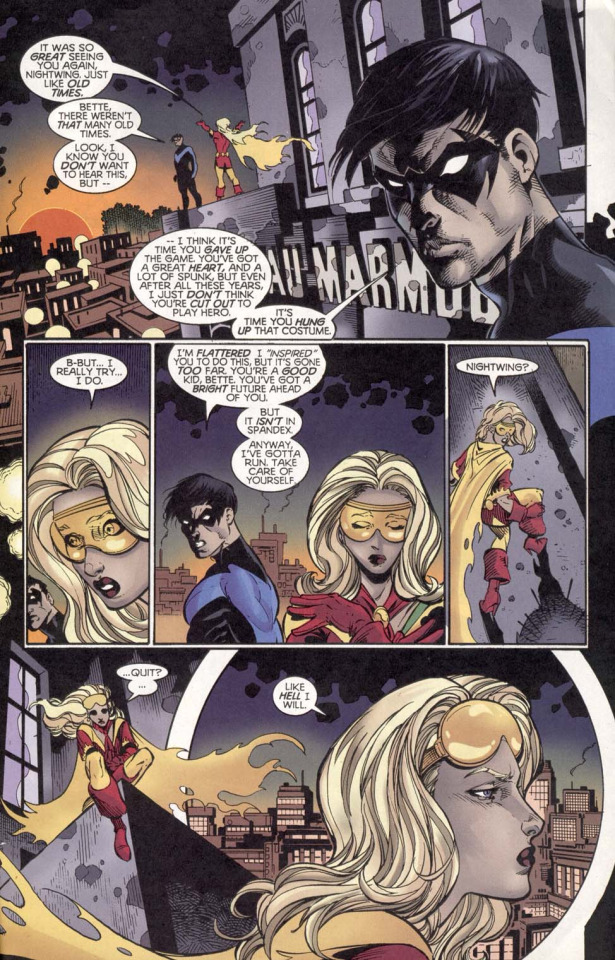
Beast Boy (2000) #3
Better gets a very stern reprimand from Nightwing (some she admires), and is told she's not cut out for this world and quits. This comes after she's spent most of her appearance in this run being kinda a comedic relief in the form of her repeated failures to bail Beast Boy outta jail (since she's never posted bail before and didn't know how)
But after this..?
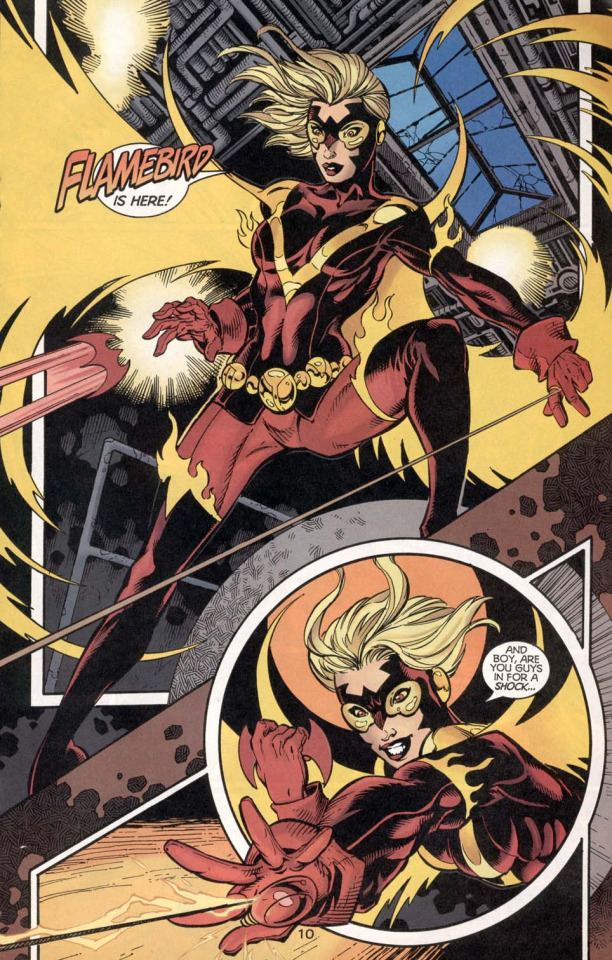
Beast Boy (2000) #4
She comes back, with a new (more practical-looking, as I discussed before) costume and beats up several bad guys to help out Gar (who in turn really appreciates her arrival and assistance).

Batwoman (2011) #3
Making this post I've noticed an interesting similarity and contrast between Beast Boy and Batwoman comics in regards to Bette. Both times, Bette gets very sternly reprimanded and told she's not cut out to be a hero and ordered not to be one by someone she admires/values the opinion of.
Both times she defies them and goes out anyway, putting on the same costume both times in fact.
But while the Beast Boy comic portrays her as competent and capable, even having her involvement appreciated by Gar...

Meanwhile in Batwoman?
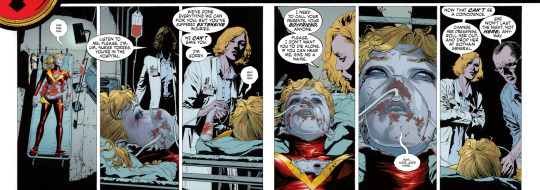
Batwoman (2011-2016) #4
Bette's defiance almost immediately ends with her horribly injured, and in turn accidentally helps the DEO work out Batwoman's identity.
Two events regarding the same character which that character reacts to in a similar manner but one ends with her vindicated and the other... very much not.
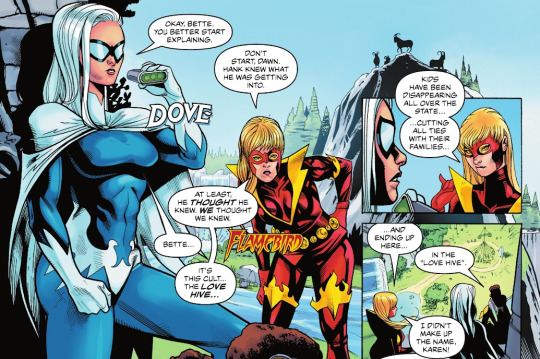
DC's Legion of Bloom (2023) #1
Moving back to Bette's recent appearance in DC's Legion of Bloom. West Point is 4-years in total, and when we last saw Bette she was on her second year at the latest. So with the nature of comic book time, I find it unlikely she'd already graduated.
Her return to Flamebird could also have something to do with Infinite Frontier (I don't fully understand how it works, but apparently everything's canon now again sort of?) re-canonising Bette's competence? That sounds like kinda an amusing thought tbh; multiverse shenanigans happen and Bette wakes up one morning feeling suddenly competent again. Good for her.
Anyway I hope this is a good sign for Bette's character. Even if she's unlikely to be a major player, would still be nice for her appearance to at least depict her as capable. Plus as I said, comic book time means if she does actually stick to West Point, then she'd unlikely to be graduating (and get allowed to be a vigilante) anytime soon. So at that point you might as well just let her go be rich and play tennis since its not like that's a route to her actually doing anything.
Bette seems pretty neat from what I've seen of her, so I wish her the best. Even if Legion of Bloom continues the running joke of her trying and failing to recreate Titans West.
#professoruber thoughts#bette kane#mary elizabeth kane#kate kane#katherine kane#batwoman#batwoman 2011#dc's legion of bloom#hawk and dove#detective comics#beast boy#beast boy 2000#gar logan#nightwing#dick grayson#hawkfire#flamebird#batgirl#bat-girl#plebe#bumblebee#dc's infinite frontier#new 52#comic criticism#comic analysis#teen titans#titans west#comic essay#tw: blood
34 notes
·
View notes
Text

Sharon Lynn-Oliver Hardy-Stan Laurel-James Finlayson "Allá en el lejano oeste" (Way out west) 1937, de James W. Horne.
13 notes
·
View notes
Note
*knocking at your door*
Excuse me do you have a moment to talk about gay cowboys??
Ok, here's some gay cowboys hc (idk if you meant Texas, the old west, or just cowboy themed stuff so I wrote about all 🤠):
Gay Texas
•Texas doesn't think he's gay he just assumes it's Austin's feelings peeping through and gets mad at Austin for "not keeping it to himself". Although, Austin is bi but doesn't know if Texas is either in denial or just plain dumb. What he does know is Texas keeps a film stills from a silent film Calfornia starred in before the 1937 Fox vault fire where it was thought to be lost.
The stills show Cali in a cowboy hat and boots kissing his co-star. It was filmed before the hay's code so it went a little far (by 1920s standards).
Actual Old west
•California was an important part of the wild west and at the time he was too socially awkward to communicate but due to his gold rush and the way he was just good at being a cowboy, all the other states respected him at that time for what they thought was "stoicism"- until they got to know Cali better and realised that it was autism and anxiety.
•In the wild west, Oklahoma and Texas had a large rivalry and began encouraging other states to join their gangs. It all came ahead when the two challenged each other to a duel, and Oklahoma took the bullets out of Texas' gun. Texas' eyes widened as he shot blanks. With the upper hand Oklahoma could have killed Texas, but in the last moment decided to shoot a barrel instead- he blamed it on the sun. Neither side believed him but to this day no one knows why Oklahoma didn't do it.
• Oregon had stomach cramps because of dysentery, and was often the butt of the joke to the other states
Wild West Rodeo (themed hc)
•Every year the old west states take it in turn to throw a western themed party/rodeo. But every decade or something happens to make a new rule for the party. These include:
-North and South Dakota should be separated when drunk or they'll kill each other
-When renting a mechanical bull, don't buy it from Nevada because you don't know where they've been. (;ಠ_ಠ)
-no skinny jeans on the mechanical bull (Cali once tore his pants and bc he was drunk he started sobbing and venting about trauma and everyone just drank more and went quiet)
-Never reveal the party to Florida. If California hosts then he has to encourage Loui to throw a party to distract him.
-Horseracing and shooting games should be done at separate times so they don't trample anyone.
-Colorado can't put his cannabis plants next to the stables.
21 notes
·
View notes
Note
What do you think of Rachel Zegler and her badmouthing Snow White every chance she gets? It seems like she doesn't even like the character but it doesn't seem smart to bash such an iconic and beloved character, who's a Disney princess no less! She's been going viral on tiktok for this reason. The beginning of this clip has made it's way into so many tiktoks all saying they hate this girl and that she doesn't deserve Snow White (I kinda agree tbh). Conversely, it did make the actress from The Little Mermaid trend positive because if nothing else, she at least loved playing Ariel.
https://www.tiktok.com/t/ZT8N8YXQP/
Hold on while I work through the mental equation where Gal Gadot would be jealous of Rachel Zegler's ~superior beauty. *The Evil Queen is beautiful in her own right. It is the opinion of the mirror that causes all the drama.* There it is.

Okay, first, having seen West Side Story and Shazam, fury of the gods, Rachel does a good job convincingly playing sweet and kind characters on screen, which makes her ideal for Snow White. Now with that said, Disney either dropped the ball on providing Rachel media training, or she's saying exactly what Disney want her to say, thinking it will appeal to feminists Zoomers.
Whether or not these are Disney's talking points, let's review (link):
"She's not going to be saved by the prince"
Um, well, okay, let's give them that in the original Grimm she was not saved by the prince.
"She's dreaming about becoming a leader"
As the commentator said, she can have both true love and a career since male superheroes do it all the time. But I would argue that in the original film, Snow White was already a leader: she survived childhood abuse and assassination attempt, ran into the forest to save herself, then ran her own household as a teenager, and never gave up believing that she deserved love and care regardless of how people treated her in the past. Above all, Snow White was a tale about resilience and never giving up on the life you desire regardless of your current circumstances.
Then the commentator point out that it makes sense for Snow White to dream about true love because she doesn't remember what it was like to be loved after her biological parents died and she was mistreated by her stepmom and forced to work as a scullery maid for years. The prince was the first person to show her affection and kindness.
I've seen Rachel disparage the OG Snow White as outdated since it's from 1937. I wished I could explain to Rachel (or her Disney handler) that in 1937, many Americans had been through WWI and the Great Depression and Americans needed a message of hope and a reminder to stay positive and carry on despite hardships. Snow White embodied this resilience, her strength is underappreciated. I mean, come on, despite the shocker of a day Snow White had with the assassination attempt and all, when she found the house, she was deeply moved by the thought that seven little children with no mother lived there, so she cleans their house to surprise them. She’s always thinking of others. And despite the horrible situation she’s in she remains kind and optimistic, and quietly holds tight to her dream.
Disney did such a great job with the first live action remake of Cinderella in 2015 that I don't understand why it was down hill from there. They kept the same character traits as the 1950s version, being kind, never giving up hope, and then improving on that. It's message about "having courage and be kind" is a very good one because it's easy to become hardened and bitter when people treat you badly, but it takes a very strong person to be kind even after all that.

44 notes
·
View notes
Text

“If we say nothing about Israel’s brazen slaughter of Palestinians, even as it is livestreamed into the most private recesses of our personal lives, we are complicit in it.”
If we say nothing about Israel’s brazen slaughter of Palestinians, even as it is livestreamed into the most private recesses of our personal lives, we are complicit in it. Something in our moral selves will be altered forever. Are we going to simply stand by and watch while homes, hospitals, refugee camps, schools, universities, archives are bombed, a million people displaced, and dead children pulled out from under the rubble? The borders of Gaza are sealed. People have nowhere to go. They have no shelter, no food, no water. The United Nations says more than half the population is starving. And still they are being bombed relentlessly. Are we going to once again watch a whole people being dehumanised to the point where their annihilation does not matter?
The project of dehumanising Palestinians did not begin with Benyamin Netanyahu and his crew—it began decades ago.
In 2002, on the first anniversary of September 11 2001, I delivered a lecture called “Come September” in the United States in which I spoke about other anniversaries of September 11—the 1973 CIA-backed coup against President Salvador Allende in Chile on that auspicious date, and then the speech on September 11, 1990, of George W. Bush, Sr., then US President, to a joint session of Congress, announcing his government’s decision to go to war against Iraq. And then I spoke about Palestine. I will read this section out and you will see that if I hadn’t told you it was written 21 years ago, you’d think it was about today.
September 11th has a tragic resonance in the Middle East, too. On the 11th of September 1922, ignoring Arab outrage, the British government proclaimed a mandate in Palestine, a follow-up to the 1917 Balfour Declaration which imperial Britain issued, with its army massed outside the gates of Gaza. The Balfour Declaration promised European Zionists a national home for Jewish people. (At the time, the Empire on which the Sun Never Set was free to snatch and bequeath national homelands like a school bully distributes marbles.)
How carelessly imperial power vivisected ancient civilisations. Palestine and Kashmir are imperial Britain’s festering, blood-drenched gifts to the modern world. Both are fault lines in the raging international conflicts of today.
In 1937, Winston Churchill said of the Palestinians, I quote, “I do not agree that the dog in a manger has the final right to the manger even though he may have lain there for a very long time. I do not admit that right. I do not admit for instance, that a great wrong has been done to the Red Indians of America or the black people of Australia. I do not admit that a wrong has been done to these people by the fact that a stronger race, a higher-grade race, a more worldly wise race to put it that way, has come in and taken their place.” That set the trend for the Israeli State’s attitude towards the Palestinians.
In 1969, Israeli Prime Minister Golda Meir said, “Palestinians do not exist.”
Her successor, Prime Minister Levi Eschol said, “What are Palestinians? When I came here (to Palestine), there were 250,000 non-Jews, mainly Arabs and Bedouins. It was a desert, more than underdeveloped. Nothing.” Prime Minister Menachem Begin called Palestinians “two-legged beasts”.
Prime Minister Yitzhak Shamir called them “grasshoppers” who could be crushed. This is the language of Heads of State, not the words of ordinary people.
Thus began that terrible myth about the Land without a People for a People without a Land.
In 1947, the U.N. formally partitioned Palestine and allotted 55 per cent of Palestine’s land to the Zionists. Within a year, they had captured 76 per cent. On the 14th of May 1948 the State of Israel was declared. Minutes after the declaration, the United States recognized Israel. The West Bank was annexed by Jordan. The Gaza Strip came under Egyptian military control, and Palestine formally ceased to exist except in the minds and hearts of the hundreds of thousands of Palestinian people who became refugees.
In 1967, Israel occupied the West Bank and the Gaza Strip. Over the decades there have been uprisings, wars, intifadas. Tens of thousands have lost their lives. Accords and treaties have been signed. Cease-fires declared and violated. But the bloodshed doesn’t end.
Palestine still remains illegally occupied. Its people live in inhuman conditions, in virtual Bantustans, where they are subjected to collective punishments, 24-hour curfews, where they are humiliated and brutalized on a daily basis. They never know when their homes will be demolished, when their children will be shot, when their precious trees will be cut, when their roads will be closed, when they will be allowed to walk down to the market to buy food and medicine. And when they will not. They live with no semblance of dignity. With not much hope in sight. They have no control over their lands, their security, their movement, their communication, their water supply. So when accords are signed, and words like “autonomy” and even “statehood” bandied about, it’s always worth asking: What sort of autonomy? What sort of State? What sort of rights will its citizens have? Young Palestinians who cannot control their anger turn themselves into human bombs and haunt Israel’s streets and public places, blowing themselves up, killing ordinary people, injecting terror into daily life, and eventually hardening both societies’ suspicion and mutual hatred of each other. Each bombing invites merciless reprisal and even more hardship on Palestinian people. But then suicide bombing is an act of individual despair, not a revolutionary tactic.
Although Palestinian attacks strike terror into Israeli citizens, they provide the perfect cover for the Israeli government’s daily incursions into Palestinian territory, the perfect excuse for old-fashioned, nineteenth-century colonialism, dressed up as a new-fashioned, 21st century “war”. Israel’s staunchest political and military ally is and always has been the US.
The US government has blocked, along with Israel, almost every UN resolution that sought a peaceful, equitable solution to the conflict. It has supported almost every war that Israel has fought. When Israel attacks Palestine, it is American missiles that smash through Palestinian homes. And every year Israel receives several billion dollars from the United States—taxpayers’ money.
Today every bomb that is dropped by Israel on the civilian population, every tank, and every bullet has the United States’ name on it. None of this would happen if the US wasn’t backing it wholeheartedly. All of us saw what happened at the meeting of the UN Security Council on December 8 when 13 member states voted for a ceasefire and the US voted against it. The disturbing video of the US Deputy Ambassador, a Black American, raising his hand to veto the resolution is burned into our brains. Some bitter commentators on the social media have called it Intersectional Imperialism.
Reading through the bureaucratese, what the US seemed to be saying is: Finish the Job. But Do it Kindly.
What lessons should we draw from this tragic conflict? Is it really impossible for Jewish people who suffered so cruelly themselves—more cruelly perhaps than any other people in history—to understand the vulnerability and the yearning of those whom they have displaced?
Does extreme suffering always kindle cruelty? What hope does this leave the human race with? What will happen to the Palestinian people in the event of a victory? When a nation without a state eventually proclaims a state, what kind of state will it be? What horrors will be perpetrated under its flag? Is it a separate state that we should be fighting for or, the rights to a life of liberty and dignity for everyone regardless of their ethnicity or religion?
Palestine was once a secular bulwark in the Middle East. But now the weak, undemocratic, by all accounts corrupt but avowedly nonsectarian PLO, is losing ground to Hamas, which espouses an overtly sectarian ideology and fights in the name of Islam. To quote from their manifesto: “we will be its soldiers and the firewood of its fire, which will burn the enemies”. The world is called upon to condemn suicide bombers. But can we ignore the long road they have journeyed on before they have arrived at this destination?
September 11, 1922 to September 11, 2002—80 years is a long time to have been waging war. Is there some advice the world can give the people of Palestine? Should they just take Golda Meir’s suggestion and make a real effort not to exist?”
The idea of the erasure, the annihilation, of Palestinians is being clearly articulated by Israeli political and military officials.
A US lawyer who has brought a case against the Biden administration for its “failure to prevent genocide”—which is a crime, too—spoke of how rare it is for genocidal intent to be so clearly and publicly articulated. Once they have achieved that goal, perhaps the plan is to have museums showcasing Palestinian culture and handicrafts, restaurants serving ethnic Palestinian food, maybe a Sound and Light show of how lively Old Gaza used to be—in the new Gaza Harbour at the head of the Ben Gurion canal project, which is supposedly being planned to rival the Suez Canal. Allegedly contracts for offshore drilling are already being signed.
Twenty-one years ago, when I delivered “Come September” in New Mexico, there was a kind of omertà in the US around Palestine. Those who spoke about it paid a huge price for doing so. Today the young are on the streets, led from the front by Jews as well as Palestinians, raging about what their government, the US government, is doing. Universities, including the most elite campuses, are on the boil. Capitalism is moving fast to shut them down. Donors are threatening to withhold funds, thereby deciding what American students may or may not say, and how they may or may not think. A shot to the heart of the foundational principles of a so-called liberal education.
Gone is any pretense of post-colonialism, multiculturalism, international law, the Geneva Conventions, the Universal Declaration of Human Rights. Gone is any pretence of Free Speech or public morality. A “war” that lawyers and scholars of international law say meets all the legal criterion of a genocide is taking place in which the perpetrators have cast themselves as victims, the colonisers who run an apartheid state have cast themselves as the oppressed. In the US, to question this is to be charged with anti-Semitism, even if those questioning it are Jewish themselves.
It’s mind-bending. Even Israel—where dissident Israeli citizens like Gideon Levy are the most knowledgeable and incisive critics of Israeli actions—does not police speech in the way the US does (although that is rapidly changing, too). In the US, to speak of Intifada—uprising, resistance—in this case against genocide, against your own erasure—is considered to be a call for the genocide of Jews.
The only moral thing Palestinian civilians can do apparently is to die. The only legal thing the rest of us can do is to watch them die. And be silent. If not, we risk our scholarships, grants, lecture fees and livelihoods.”

Arundhati Roy
13 notes
·
View notes
Text
Elwing, Elros & Elrond ramblings
I imagine that Elwing and Elrond were interested to meet one another when Elrond finally sailed to Valinor. There would be some big emotions flying around there.
But I don't believe that Elwing has been longing for her son for six thousand years, or that their relationship would immediately be warm. That's not because of Elwing's choices, which seem legendary but unimpeachable. It's because of Elrond's choices.
My big question with Elrond is why is he still there in Middle-earth?
He could have left with his brother at the end of the War of Wrath, gone to Numenor, then perhaps sailed west to rejoin his mother when his brother died, or when his nephews or grand-nephews did.
That would be entirely in keeping with an Elrond who missed his parents, loved his brother, felt reasonably confident in the power of the Valar, and was obedient to their counsel that the Elves should sail to Valinor.
The threat in middle-earth was, so far as anyone knew, ended. His childhood and youth were spent in a place increasingly overwhelmed by war, and his original childhood home was lost.
But OK, maybe he wants to enjoy the peace, with Galadriel, Celeborn, Cirdan & Celebrimbor, who have their own reasons not to leave, plus Gil-galad and whatever Noldor and Sindar chose to linger in the Hither Lands. Maybe Elrond likes Men and Dwarves, and wants to stay with them too. (Maybe he's even spending time with Maglor, if the 1937 Silmarillion has that bit right.)
All reasonable feelings for Elrond. After all, people don't generally come back once they have sailed into the West.
(I think? It has just occurred to me that since there is a long period when elven ships regularly visited Numenor from Valinor, and Mannish ships visited Lindon, and Elrond has chosen to be an Elf, it is possible that he visited Valinor, or at least the Lonely Isle.
Perhaps Elrond's departure at the end of the Third Age was a journey to a home that he had visited regularly in the Second Age? I don't think I've seen that interpretation before but I can't see anything to entirely rule it out! However, this intriguing theory breaks the theory I was typing so let us ignore it.)
So. Assuming that Elrond remains in Middle-earth throughout his life until his final journey after the War of the Ring, that does mean he prioritised life in Middle-earth over re-union with his mother and possibly father (if you assume Earendil gets breaks from being a star).
Elwing can't return, but Elrond could leave. Elros did, after all, and moved to an island as close as possible to Valinor, even if his ultimate decision to become a Man took him away from his parents in the end.
So, in the Second Age, Elrond makes his own choices, and they don't involve reunions with his parents, so far as we can tell.
Then Sauron falls, Gil-galad falls. Elrond could quite easily sail at that point. But there is Celebrian. Perhaps she doesn't want to leave her mother - though you wonder. If Celebrian and Elrond had married and then gone to Valinor, then very likely all their children would have chosen to be Elves. But Elrond, again, makes the reasonable adult choice to prioritise his wife, friends, perhaps family responsibilities, over safety and reunion with his parents across the Sea.
And he sticks it out in Middle-earth right to the bitter end. Even after Celebrian is wounded and has to sail to Valinor. Elrond is very definitely not someone in a rush to get to Valinor.
So, really, I very much hope that Elwing had friends and occupations and enjoyment that did not in any way centre around her children.
I can't really see why she should not. She spent seven years with her children, and seven thousand without them. Mothers are also people! I hope she had a period where she was able to come to grips with her grief, and then went on with her life.
72 notes
·
View notes
Text
WHAT IS THE KARDASHEV SCALE??
Blog#295
Wednesday, May 10th, 2023
Welcome back,
Are we alone in the Universe? Could there be countless sentient life forms out there just waiting to be found? Will we meet them someday and be able to exchange knowledge? Will we even recognize them as intelligent life forms if/when we meet them, and them us? When it comes to astrobiology, the search for life in the Universe, we don’t know what to expect. Hence why all the speculation and theoretical studies into these questions are so rich and varied!

One such study was conducted by famed Soviet and Russian astrophysicist and radio astronomer Nikolai Kardashev (1932 – 2019). While considering an important question related to the Search for Extraterrestrial Intelligence (SETI) in 1964, Kardashev proposed a classification scheme for ranking a civilization’s development. This would come to be known as the Kardashev Scale, which remains one of the most influential concepts in SETI to this day.

In 1960, the first modern attempt to detect extraterrestrial communications (“Project Ozma“) was made in the United States. Led by Frank Drake, creator of the Drake Equation and hailed as the “Father of SETI,” this experiment was conducted using the radio telescope at the National Radio Astronomy Observatory in Green Bank, West Virginia.
This experiment monitored two nearby Sun-like stars – Tau Ceti and Epsilon Eridani – for radio signals in the 1420 MHz range, corresponding to the frequency of cold hydrogen gas in interstellar space.

While the project failed to detect anything beyond radio static, Ozma paved the way for far more ambitious SETI (and METI) efforts. It also inspired astrophysicists worldwide to consider what future surveys should be on the lookout for.
At a time when a search for extraterrestrial intelligence was more a thought experiment than an actual discipline, physicists in the Soviet Union formulated many of the seminal ideas that would endure until this day. Of these, Nikolai Kardashev was one of the earliest and most consequential thinkers, and his ideas remain foundational to the field of SETI

Coming of age in the postwar era, Kardashev studied under Josef Shklovskii (1916-1985), the celebrated author of Intelligent Life in the Universe. This book was the first general treatise on how humans could search for technologically capable beings in the cosmos. Shklovskii’s book was translated (and added to) by Carl Sagan and became the inspiration for many scientists after it was published in 1966 in the West.
For much of his formative years, Kardashev was on his own. His mother and father were both victims of the Great Purge in 1937 and 38 (respectively), and he was sent to an orphanage.

He was eventually released into the custody of his aunt (on his mother’s side), who died in 1948 when Kardashev was 16. His father was eventually shot while his mother worked in a prison labor camp until she was released in 1956.
A year before, Kadashev graduated from Moscow State University, where his studies focused on radio astronomy, an emerging field at the time.
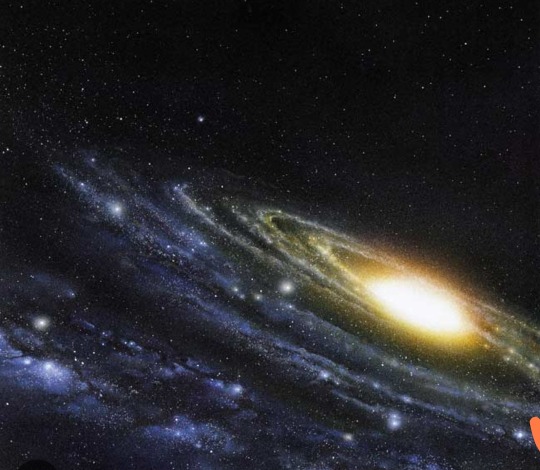
He then worked at the Sternberg Astronomical Institute in Moscow, earning his Ph.D. in 1962. Kardashev’s early exposure to the fundamental premises of SETI led him to turn his inventive mind to how radio astronomy could be used to detect transmissions that were not terrestrial in origin.
This paper, titled “Transmission of Information by Extraterrestrial Civilizations,” was published in 1964. The paper’s purpose was to suggest what types of radio frequencies (and at what energies) SETI researchers should be looking for.
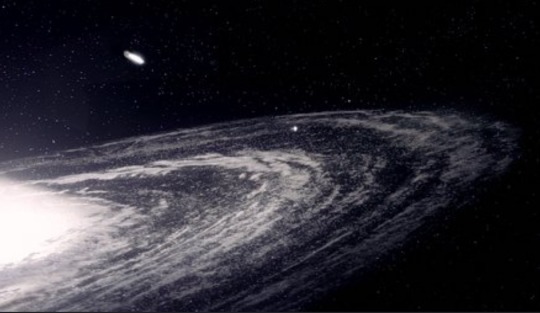
In keeping with the idea that there may be some civilizations billions of years older than humanity, it stood to reason that these civilizations would be able to harness levels of energy that were not humanly possible.
To characterize the potential level of a civilization’s development, Kardashev proposed a three-level scale based on the amount of energy they could harness. This Scale included:

Type I – Planetary Civilizations: This refers to those that have developed the means to harness and store all of their home planet’s energy. According to Kardashev, this would amount to the consumption of 4×1019 erg/sec, which would likely be in the forms of fusion power, antimatter, and renewable energy on a global scale.
Originally published on universetoday.com
COMING UP!!
(Saturday, May 13th, 2023)
"WHAT IS THE KARDASHEV SCALE?? TYPE 2 CIVILIZATION!!"
#astronomy#outer space#alternate universe#astrophysics#spacecraft#universe#white universe#space#parallel universe#astrophotography
53 notes
·
View notes
Text

“If cannabis were discovered in the Amazon rainforest today, people would be clambering to make as much use as they could of all of the potential benefits of the plant. Unfortunately, it carries with it a long history of being a persecuted plant.” ~ Dr. Donald Abrams, Chief of Hematology Oncology at San Francisco General Hospital
Approximately 106,000 Americans die yearly from prescribed medications, according to the American Medical Association. Even more frightening, preventable medical errors account for a staggering 400,000 deaths in the U.S. each year — and is considered the 3rd leading cause of death. “It’s equivalent to 2,000 commercial jets taking off each year knowing that they don’t have enough fuel to complete their journeys,” notes Peter Edelstein M.D. “Would you allow your spouse to board one of those planes? Your friend? A stranger?”
Good question. Increasingly, people in the West are seeking out treatments that work harmoniously with the body, instead of against it — in other words, they’re walking away from the medical establishment and all its mishaps, mistakes and pharmaceutical drugs. A case in point is cannabis, especially in its raw form.
A Rich History
Marijuana is one of those plants that, to many, conjures visions of Drug Enforcement Administration (DEA) raids and hippies in a drugged-out daze. But it wasn’t always this way.
“The ancient Chinese knew of marijuana’s pain-relieving and mind-altering effects, yet it was not widely employed for its psychoactive properties; instead it was cultivated as hemp for the manufacture of rope and fabric. Likewise, the ancient Greeks and Romans used hemp to make rope and sails. In some other places, however, marijuana’s intoxicating properties became important. In India, for example, the plant was incorporated into religious rituals. During the Middle Ages, its use was common in Arab lands; in 15th-century Iraq it was used to treat epilepsy; in Egypt it was primarily consumed as an inebriant. After Napoleon’s occupation of Egypt, Europeans began using the drug as an intoxicant. During the slave trade, it was transported from Africa to Mexico, the Caribbean and South America. Marijuana gained a following in the U.S. only relatively recently. During the second half of the 19th century and the beginning of the 20th, cannabis was freely available without a prescription for a wide range of ailments, including migraine and ulcers,” Roger A. Nicoll and Bradley N. Alger remind us in Scientific American.
Even American Founding Father Thomas Jefferson declared: “Hemp is of first necessity to the wealth and protection of the country.”
So what happened?
In 1937, the United States Congress decided — against the recommendation of the American Medical Association — to pass the Marijuana Tax Act. The legislation essentially banned the use of marijuana by making it excessively expensive and difficult to secure. It has been downhill ever since. That is, until the last few years where legalization of marijuana has exploded in the U.S., for both recreational and medicinal uses. For our purposes here, we’re going to look at the health benefits of the plant — which are quite impressive.
An Essential Vegetable
“It [cannabis] has captured these molecules that help our bodies regulatory system be more effective. The bottom line is it’s a dietary essential that helps all 210 cell types function more effectively. I don’t even refer to it as medicine anymore, strictly as a dietary essential.”
~ Dr. William L. Courtney
It may be a stretch for some to recognize rawcannabis as the next in-demand superfood, but Dr. Courtney, a physician with extensive medical training who specializes in the dietary uses of cannabis, presents a provocative case.
When you heat or age cannabis, Dr. Courtney believes that you lose 99% of the benefit cannabis provides. In contrast, if you consume it raw, you’ll reap the full value of the plant. Plus, raw cannabis is non-psychoactive, so you won’t experience a high — an important point for those who would like to utilize the healing aspects of cannabis without feeling drugged or off-center. This means you can also consume a much higher amount of health-promoting compounds with raw cannabis juice compared to if it was smoked or extracted as an oil, according to Dr. Courtney.
Terpenes, essential oils found in cannabis which give the plant its unique aroma, are particularly compelling.A study published in the British Journal of Pharmacology states that terpenoids are “pharmacologically versatile: they are lipophilic, interact with cell membranes, neuronal and muscle ion channels, neurotransmitter receptors, G-protein coupled (odorant) receptors, second messenger systems and enzymes.”
The researchers explored the powerful effect terpenes exert in animal tests. Limonene was found to increase serotonin in the prefrontal cortex and dopamine in the hippocampus region of the brain — both of which help fend-offdepression and feelings of stress. Moreover, limonene induces apoptosis (cell death) of breast cancer cells and demonstrated exceptional radical scavenging properties. It’s also remarkably bioavailable, rapidly metabolized and is highly non-toxic and non-sensitizing.
Myrcene is anti-inflammatory and an effective sleep aid, while pinene acts as a bronchodilator and broad spectrum antibiotic — including the destruction of lethal MRSA bacteria. Pinene also curbs inflammation. Linalool is a sedative and anticonvulsant. Caryophyllene is antimalarial, anti-inflammatory and useful in treating duodenal ulcers. Nerolidol inhibits fungal growth and protozoal parasites. Phytol increases GABA expression, resulting in a calming effect. These are just a handful of the 200 varieties of terpenes found in cannabis.
How to Enjoy More Raw Cannabis in Your Life
For a daily dose, Dr. Courtney advises juicing fifteen cannabis leaves and two buds, which is then added to a small amount of fruit or vegetable juice that is consumed throughout the day. If you would like to learn more about juicing cannabis, this article offers tips and suggestions. Keep in mind that juicing improperly may create heat, which will cause THC to form. Jeffrey C. Raber, Ph.D. also recommends having the strain of marijuana you’re using tested at a reliable and accurate lab so you know exactly what you are getting.
Article sources:
www.psychologytoday.com
www.humboldtjustice.com
www.globalhealingcenter.com
www.cannabisinternational.org
www.ncbi.nlm.nih.gov
www.huffingtonpost.com
www.projectcbd.org
8 notes
·
View notes
Photo

James Finlayson
29 notes
·
View notes
Text
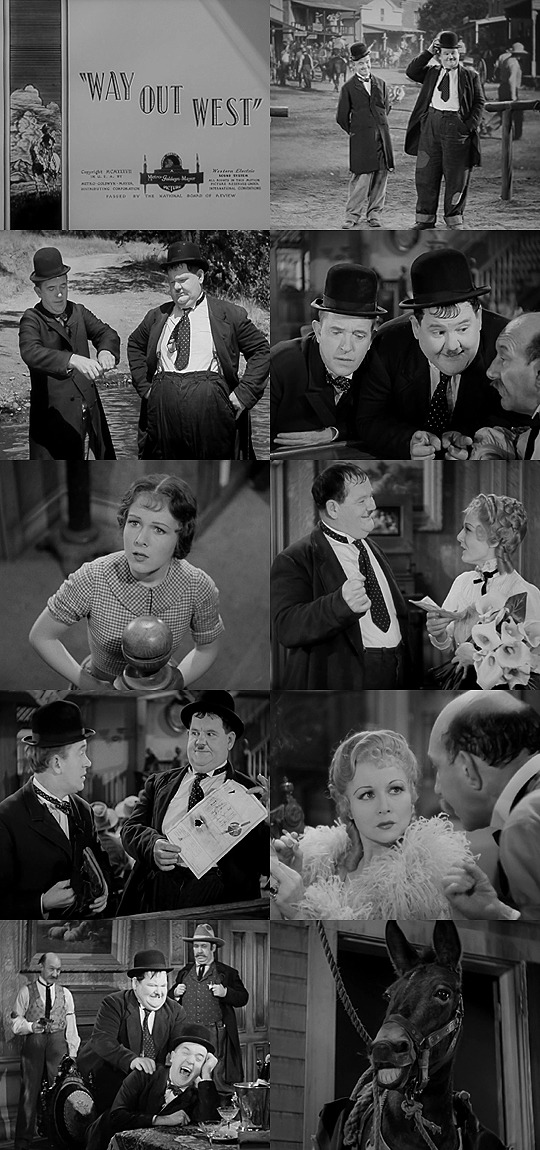
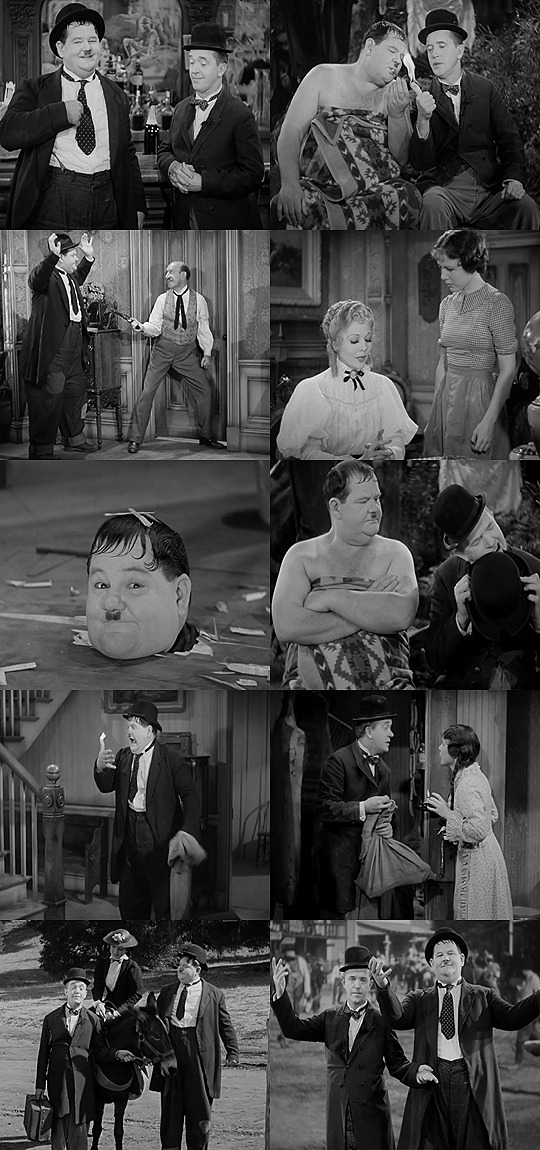
Films Watched in 2023:
61. Way Out West (1937) - Dir. James W. Horne
#Way Out West#James W. Horne#Stan Laurel#Oliver Hardy#Rosina Lawrence#James Finlayson#Sharon Lynn#Chill Wills#Stanley Fields#Dinah#Laurel and Hardy#Laurel & Hardy#Films Watched in 2023#My Edits#My Post
17 notes
·
View notes
Text
Philip wanted to sue The Crown after being blamed for sister’s death
Duke consulted royals’ favorite law firm after plotline left him ‘hurt and upset’
The Duke of Edinburgh spoke to his lawyers about suing Netflix over a false portrayal of him in The Crown that left him deeply “upset”.
Prince Philip consulted Farrer & Co, the blue-blooded law firm that has advised the royal family since the 1930s, after the series featured a plotline about the death of his older sister, Princess Cecilie.
Hugo Vickers, a royal historian and author, said: “I know Prince Philip consulted his lawyer about it, to ask ‘What can I do about it?’ He was very upset about the way that was portrayed. He was human. He could be hurt like anybody else.”
The plot features in the penultimate episode of the second series, which was first broadcast in 2017, without a fictional disclaimer. It includes imagined scenes in which Philip, then aged 16, is involved in a misdemeanour at his boarding school, Gordonstoun, resulting in him not being allowed to spend his half-term break in Germany with Cecilie, who is heavily pregnant with her fourth child. In the Netflix drama, she is depicted telling Philip she will consequently be forced to fly to London to attend a wedding with her family.
Cecilie, 26, the third of Philip’s four older sisters, was killed in a plane crash in November 1937 with her husband and their two young sons when their plane hit a factory chimney in fog near Ostend. She had given birth during the flight and her baby’s body was found alongside her in the wreckage.
In the Netflix dramatisation of Cecilie’s funeral, their father, Prince Andrew of Greece and Denmark, says to onlookers and a tearful Philip: “I’m surprised he dare show himself here. Had it not been for Philip and his indiscipline she would never have taken that flight. It’s true, isn’t it boy? You’re the reason we’re all here burying my favourite child. Get him out of here.”
However, her decision to travel to London had nothing to do with Philip, who was particularly close to Cecilie. Her death deeply affected him and in later life he recalled being summoned to his headmaster’s study and informed of her death: “I have the very clearest recollection of the profound shock with which I heard the news of the crash and the death of my sister and her family.”
While staying with the Queen and Philip, a close friend of the royal family said Philip had expressed anger at his portrayal. “I remember sitting next to the Duke of Edinburgh at a dinner, and him being so upset about it and what it [The Crown] was saying about him.”
Vickers, the author of The Crown Dissected, which sets out errors in the series, said: “[Philip] was not displeased when I put the record straight.” Philip chose not to pursue legal action and the long-held royal mantra of “never complain, never explain” prevailed.
It can also be revealed that the Prince of Wales believes The Crown is “damaging” to the royal family. A close friend of Prince William, who is played by the child actors Timothee Sambor and Senan West in the new series, said he found the fallout from the series increasingly difficult as the events portrayed come closer to the present day.
The friend said: “He has spoken about it, and now, as it is coming closer to the present, he is particularly concerned about it. William does think it is damaging. The royal family know a lot of it is nonsense, but it is really harsh and hurtful.”
The revelations give new insight into how personally wounding The Crown has proved for some members of the royal family, and how opposed their views are to those of the Duke of Sussex, who is working with Netflix on two projects as part of a his multimillion-pound deal.
In an interview with James Corden last year, Harry said the series was not “strictly accurate” but said it was “loosely based on the truth” and gave a “rough idea” of the pressures of royal life. He added that he is “way more comfortable with The Crown than I am seeing stories written about my family or my wife”.
(source)
35 notes
·
View notes
Text

“Come and take it”
On October 2, 1835, a skirmish west of Gonzales signaled an enormous change in territorial leadership, politics, and culture, and paved the way for Texas to become a republic. The incident grew out of Col. Domingo de Ugartechea’s demand late in September for return of a cannon that had been given to the settlement for defense against Native Americans. Gonzales alcalde Andrew Ponton sent word to other colonists that he had refused to surrender the cannon, which on September 29 was buried in a peach orchard. From September 30 to October 2, the number of defenders at Gonzales had grown from 18 to about 160. They dug up the cannon, mounted it on oxcart wheels, filled it with chains and scrap iron, crossed the river, and marched toward the Mexican troops led by Francisco de Castañeda. When Castañeda requested that the cannon be returned to the Mexican military, the defiant Texians issued a challenge: “Come and take it.” A discharge from the six-pounder cannon caused Castañeda and his force to retreat, and became known as the first shot of the Texas Revolution.
The approximate site where Texians fired the cannon was first marked in 1903 through the efforts of local schoolchildren. In the 1930s, the event was selected for special commemoration as part of the statewide Texas Centennial celebration, with the 1937 dedication of a granite and bronze monument. In 1937, the Texas Highway Department completed a spur connecting the Centennial monument park with the 1903 dedication site, thus creating one of the first Texas state highways designed for the sole purpose of providing vehicular access to a historic site. The First Shot Monuments Historic District in the unincorporated community of Cost was listed in the National Register of Historic Places in 2017.
- Texas Historical Commission
42 notes
·
View notes
Text
The 100 Best Films of the 1930s

The most magical decade in all of cinema, ranked and rated high-to-low:
1. City Lights (1931) ★★★★★★★★★★
2. It Happened One Night (1934) ★★★★★★★★★★
3. Duck Soup (1933) ★★★★★★★★★★
4. The Invisible Man (1933) ★★★★★★★★★★
5. The Hunchback of Notre Dame (1939) ★★★★★★★★★★
6. The Wizard of Oz (1939) ★★★★★★★★★★
7. The 39 Steps (1935) ★★★★★★★★★★
8. The Smiling Lieutenant (1931) ★★★★★★★★★★
9. Ninotchka (1939) ★★★★★★★★★★
10. The Cat and the Canary (1939) ★★★★★★★★★★
11. Horse Feathers (1932) ★★★★★★★★★☆
12. Frankenstein (1931) ★★★★★★★★★☆
13. Pygmalion (1938) ★★★★★★★★★☆
14. The Adventures of Robin Hood (1938) ★★★★★★★★★☆
15. My Man Godfrey (1936) ★★★★★★★★★☆
16. Animal Crackers (1930) ★★★★★★★★★☆
17. Monkey Business (1931) ★★★★★★★★★☆
18. A Night at the Opera (1935) ★★★★★★★★★☆
19. The Lady Vanishes (1938) ★★★★★★★★★☆
20. The Thin Man (1934) ★★★★★★★★★☆
21. Top Hat (1935) (1935) ★★★★★★★★★☆
22. The Most Dangerous Game (1932) ★★★★★★★★★☆
23. The Port of Shadows (1938) ★★★★★★★★★☆
24. The Scarlet Pimpernel (1934) ★★★★★★★★★☆
25. Love Me Tonight (1932) ★★★★★★★★★☆
26. The Merry Widow (1934) ★★★★★★★★★☆
27. One Hour with You (1932) ★★★★★★★★★☆
28. Trouble in Paradise (1932) ★★★★★★★★★☆
29. Dr. Jekyll and Mr. Hyde (1931) ★★★★★★★★★☆
30. Nothing Sacred (1937) ★★★★★★★★★☆
31. Oliver the Eighth (1934) ★★★★★★★★★☆
32. Midnight (1939) ★★★★★★★★★☆
33. Towed in a Hole (1932) ★★★★★★★★★☆
34. Gone with the Wind (1939) ★★★★★★★★★☆
35. Bride of Frankenstein (1935) ★★★★★★★★★☆
36. La Grande Illusion (1937) ★★★★★★★★★☆
37. Boudu Saved from Drowning (1932) ★★★★★★★★½☆
38. La Chienne (1931) ★★★★★★★★½☆
39. The Petrified Forest (1936) ★★★★★★★★½☆
40. M (1931) ★★★★★★★★½☆
41. King Kong (1933) ★★★★★★★★½☆
42. The Man Who Could Work Miracles (1936) ★★★★★★★★☆☆
43. Pépé le Moko (1937) ★★★★★★★★☆☆
44. Topper (1937) ★★★★★★★★☆☆
45. Tarzan the Ape Man (1932) ★★★★★★★★☆☆
46. Queen Christina (1933) ★★★★★★★★☆☆
47. Freaks (1932) ★★★★★★★★☆☆
48. Mr. Smith Goes to Washington (1939) ★★★★★★★★☆☆
49. The Music Box (1932) ★★★★★★★★☆☆
50. All Quiet on the Western Front (1930) ★★★★★★★★☆☆
51. Modern Times (1936) ★★★★★★★★☆☆
52. Baby Face (1933) ★★★★★★★★☆☆
53. The Miracle Woman (1931) ★★★★★★★★☆☆
54. The Awful Truth (1937) ★★★★★★★★☆☆
55. The Scarlet Empress (1934) ★★★★★★★★☆☆
56. Young and Innocent (1937) ★★★★★★★★☆☆
57. Jewel Robbery (1932) ★★★★★★★★☆☆
58. Snow White and the Seven Dwarfs (1937) ★★★★★★★★☆☆
59. Way Out West (1937) ★★★★★★★★☆☆
60. A Tale of Two Cities (1935) ★★★★★★★★☆☆
61. Ruggles of Red Gap (1935) ★★★★★★★★☆☆
62. Island of Lost Souls (1932) ★★★★★★★★☆☆
63. The Gay Divorcee (1934) ★★★★★★★★☆☆
64. Busy Bodies (1933) ★★★★★★★★☆☆
65. History Is Made at Night (1937) ★★★★★★★★☆☆
66. Stagecoach (1939) ★★★★★★★★☆☆
67. Morocco (1930) ★★★★★★★★☆☆
68. Bringing Up Baby (1938) ★★★★★★★★☆☆
69. Marie Antoinette (1938) ★★★★★★★★☆☆
70. Dracula (1931) ★★★★★★★★☆☆
71. Bizarre, Bizarre (1937) ★★★★★★★★☆☆
72. Let's Make a Dream (1936) ★★★★★★★★☆☆
73. I Am a Fugitive from a Chain Gang (1932) ★★★★★★★★☆☆
74. Wuthering Heights (1939) ★★★★★★★★☆☆
75. Grand Hotel (1932) ★★★★★★★★☆☆
76. L'Age d'Or (1930) ★★★★★★★★☆☆
77. The Hound of the Baskervilles (1939) ★★★★★★★★☆☆
78. Blonde Bombshell (1933) ★★★★★★★★☆☆
79. Scarface (1932) ★★★★★★★★☆☆
80. Under the Roofs of Paris (1930) ★★★★★★★★☆☆
81. À Nous la Liberté (1931) ★★★★★★★★☆☆
82. Block-Heads (1938) ★★★★★★★★☆☆
83. Public Enemy (1931) ★★★★★★★★☆☆
84. Destry Rides Again (1939) ★★★★★★★★☆☆
85. Lady for a Day (1933) ★★★★★★★★☆☆
86. Charlie Chan at Treasure Island (1939) ★★★★★★★★☆☆
87. A Star Is Born (1937) ★★★★★★★★☆☆
88. Shanghai Express (1932) ★★★★★★★★☆☆
89. The Sign of The Cross (1932) ★★★★★★★½☆☆
90. Christine (1937) ★★★★★★★½☆☆
91. Platinum Blonde (1931) ★★★★★★★½☆☆
92. Sabotage (1936) ★★★★★★★☆☆☆
93. Kongo (1932) ★★★★★★★☆☆☆
94. Lost Horizon (1937) ★★★★★★★☆☆☆
95. The Old Dark House (1932) ★★★★★★★☆☆☆
96. Design for Living (1933) ★★★★★★★☆☆☆
97. The Blue Angel (1930) ★★★★★★★☆☆☆
98. The Man Who Knew Too Much (1934) ★★★★★★★☆☆☆
99. Death Takes a Holiday (1934) ★★★★★★★☆☆☆
100. The Story of Temple Drake (1933) ★★★★★★★☆☆☆

67 notes
·
View notes